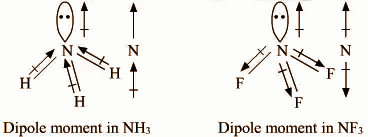
Which out of
Answer
477.3k+ views
Hint: Dipole moment is a vector quantity and hence the resultant dipole moment in a molecule depends upon the direction of dipole moments of individual bonds. In
Complete answer:
In both molecules i.e.,
In
Since in the case of
F is more electronegative than H and N−F bond is more polar than N−H bond. Hence,

Dipole moment in
Hence, the net dipole moment of
Note: Ammonia is an inorganic compound which is composed of a single nitrogen atom that is covalently bonded to three hydrogen atoms. It is manufactured as well as produced naturally from bacterial processes and the breakdown of organic matter. Ammonia is used in many industrial processes, and it is also used as a fertilizer and refrigerant. It is a colorless gas or compressed liquid which has a pungent odor and exposure occurs by inhalation, ingestion, or in contact.
Complete answer:
In both molecules i.e.,
In
Since in the case of
F is more electronegative than H and N−F bond is more polar than N−H bond. Hence,

Dipole moment in
Hence, the net dipole moment of
Note: Ammonia is an inorganic compound which is composed of a single nitrogen atom that is covalently bonded to three hydrogen atoms. It is manufactured as well as produced naturally from bacterial processes and the breakdown of organic matter. Ammonia is used in many industrial processes, and it is also used as a fertilizer and refrigerant. It is a colorless gas or compressed liquid which has a pungent odor and exposure occurs by inhalation, ingestion, or in contact.
Latest Vedantu courses for you
Grade 10 | CBSE | SCHOOL | English
Vedantu 10 CBSE Pro Course - (2025-26)
School Full course for CBSE students
₹37,300 per year
Recently Updated Pages
Master Class 9 General Knowledge: Engaging Questions & Answers for Success

Master Class 9 English: Engaging Questions & Answers for Success

Master Class 9 Science: Engaging Questions & Answers for Success

Master Class 9 Social Science: Engaging Questions & Answers for Success

Master Class 9 Maths: Engaging Questions & Answers for Success

Class 9 Question and Answer - Your Ultimate Solutions Guide

Trending doubts
State and prove Bernoullis theorem class 11 physics CBSE

Who built the Grand Trunk Road AChandragupta Maurya class 11 social science CBSE

1 ton equals to A 100 kg B 1000 kg C 10 kg D 10000 class 11 physics CBSE

State the laws of reflection of light

One Metric ton is equal to kg A 10000 B 1000 C 100 class 11 physics CBSE

Difference Between Prokaryotic Cells and Eukaryotic Cells




